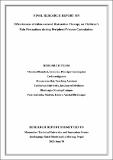Please use this identifier to cite or link to this item:
https://hdl.handle.net/20.500.14356/2686Full metadata record
| DC Field | Value | Language |
|---|---|---|
| dc.contributor.author | Bhandari, Menuka | - |
| dc.contributor.author | Rai, Munawatee | - |
| dc.contributor.author | Gartaula, Puja | - |
| dc.date.accessioned | 2025-04-28T08:19:29Z | - |
| dc.date.available | 2025-04-28T08:19:29Z | - |
| dc.date.issued | 2023 | - |
| dc.identifier.citation | Manmohan Technical University and Innovation Centre. 2023. Effectiveness of video-assisted distraction therapy on children’s Pain perceptions during peripheral venous cannulation. Budhiganga Rural Municipality Morang [Nepal]. | en_US |
| dc.identifier.uri | https://hdl.handle.net/20.500.14356/2686 | - |
| dc.description | Research Report. | en_US |
| dc.description.abstract | ABSTRACT Relief of pain is a basic need and right of all children; effective pain management requires health professionals to be able to apply a number of interventions to achieve optimal results. The current study was aimed to discover Effectiveness of Video-assisted Distraction Therapy on Children‟s Pain Perceptions during Peripheral Venous Cannulation at Pediatric Wards of Biratnagar. A quasi-experimental study was conducted at Pediatric Wards of different hospitals of Biratnagar. Data collection was done from Feb 27, 2023 to April 28, 2023. Non probability purposive sampling technique was adopted in selecting the desired sample size. Data was collected through an interview questionnaire format for socio-demographic information and a standard observational checklist of Assessments of the face, legs, activity, crying, and the consoleability (FLACC) pain rating scale was used to assess the pain perception of children. An animated cartoon video including short story, movie as per children's age group and language preference was used by the researcher. Experimental group received the video assisted distraction therapy as an intervention, while the control group received routine intravenous care by the nurses. Statistical analysis such as frequency, percentage, mean, range, SD, independent t-test, Fisher exact test were used. The study findings has shown that there is significant difference between the pain perception score in experimental and control group during peripheral venous cannulation which suggest that the pain perception in experimental group is lower than the control group (p= <0.001) during and after two minutes of cannulation. Similarly the level of pain was also difference in both group, 42.5% children in experimental group has perceived moderate pain, 37.5% perceived mild pain and 20% reported severe pain whereas 92.5% respondents perceived severe pain and only 7.5% has perceived moderate pain during peripheral venous cannulation. The study has strongly recommended that the distraction therapy is the effective method to relief pain during painful procedure. Keywords: Peripheral Venous Cannulation, Distraction Therapy, Pain Perceptions | en_US |
| dc.description.sponsorship | The University Grants Commission (UGC) | en_US |
| dc.language.iso | en_US | en_US |
| dc.publisher | Manmohan Technical University and Innovation Centre | en_US |
| dc.subject | Peripheral Venous Cannulation | en_US |
| dc.subject | Distraction Therapy | en_US |
| dc.subject | Pain Perceptions | en_US |
| dc.title | Effectiveness of video-assisted distraction therapy on children’s Pain perceptions during peripheral venous cannulation | en_US |
| dc.type | Research report | en_US |
| Appears in Collections: | UGC Grant Reports | |
Files in This Item:
| File | Description | Size | Format | |
|---|---|---|---|---|
| RES01208-BHA-2023.pdf | 1.21 MB | Adobe PDF |  View/Open |
Items in DSpace are protected by copyright, with all rights reserved, unless otherwise indicated.
